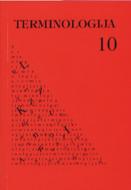Antano Vileišio (1856-1919) medicinos mokslo darbai ir jų terminija
Antanas Vileišis' (1856-1919) works of medical science and their terminology
Author(s): Palmira ZemlevičiūtėSubject(s): Language and Literature Studies
Published by: Lietuvių Kalbos Institutas
Keywords: Vileišis; medical terminology; synonym; variant; foreign term; borrowed term; naming; phonetic variant
Summary/Abstract: The article deals with one of the many fields of activities of a famous public figure in Vilnius and doctor A. Vileišis - the popularising of the knowledge of medical science in the press and the most significant features of medical terminology in books and articles, translated or written by Vileišis. Borrowed terms, Lithuanian terms and terms of the mixed origin used by Vileišis to name one medical concept and their synonyms and variants are discussed more widely. Naming various diseases, their symptoms and other medical concepts he gave the priority to the Lithuanian term and presented synonymic foreign term in brackets, for instance, būdas (temperamentas) (temper / temperament); džiova (tuberkulosas) (tuberculosis); vidurinis akių valktis (gliaukoma) (glaucoma). Less frequently the foreign term is given first and followed by the Lithuanian synonym in brackets, for instance, nervai (dirksniai) (nerves); pulsas (gyslos tvinksėjimas) (pulse). There are only a few foreign terms (including their synonyms and variants) for which Lithuanian equivalent was not given, for instance, histerija / hysterija (hysteria), migrena (migraine). In his works Vileišis used many variants and synonyms of the Lithuanian term. The most frequent are orthographic and phonetic variants: akįs / akys (eyes), klajojimas / klejojimas (delirium). Synonyms of terms are particularly plentiful – 1) one-word, for instance, geltligė / gelta (jaundice), mažakraujystė / mažakraujybė / mažakraujė (anaemia); sloga / slunktas (sloga) / slanktas / slunktas / slunkstas ((head) cold); 2) complex terms, mostly two-word terms (usually one component, most frequently specific component, has a synonym), for instance, balti / baltiejie kraujo skritulėliai (white blood cells); rėknės, arba gerklės, uždegimas (throat inflammation); 3) one-word terms and complex terms, for instance, kraujagyslės / kraujagysliai / kraujo gįslos (blood-vessel); vėjiniai raupai / vėjo raupai / vėjarauplės (chicken-pox). Often parts of a synonymic chain are variants. The abundance of synonyms and variants in Vileišis’ works shows his aim to give preference to Lithuanian terms. It also allows us to assume that he was looking for the most suitable, the best Lithuanian term to name a medical concept. At that time Lithuanian terminology of this field was being created and Vileišis with his numerous popular works of medical science made an important contribution.
Journal: Terminologija
- Issue Year: 2003
- Issue No: 10
- Page Range: 84-106
- Page Count: 23
- Language: Lithuanian

